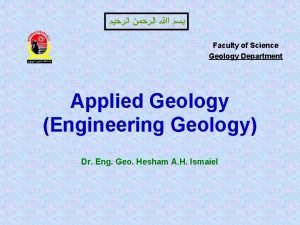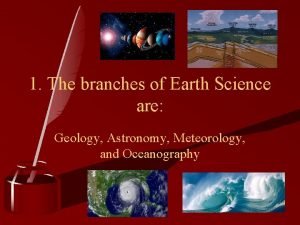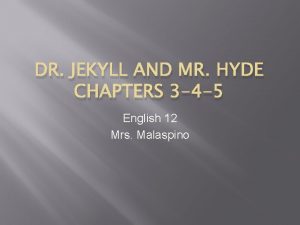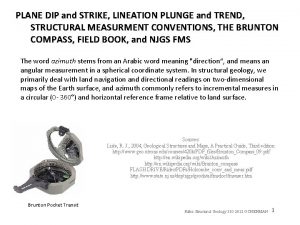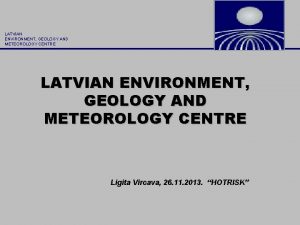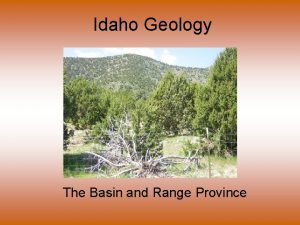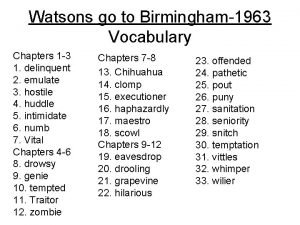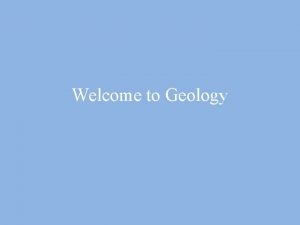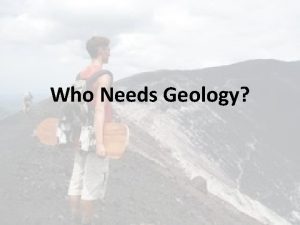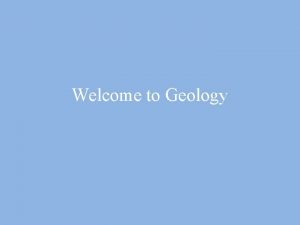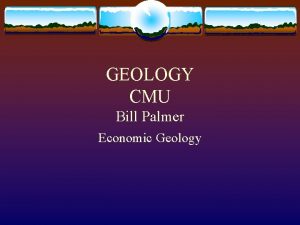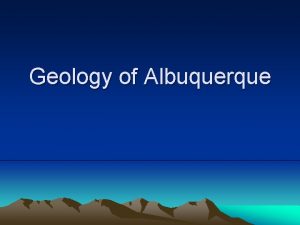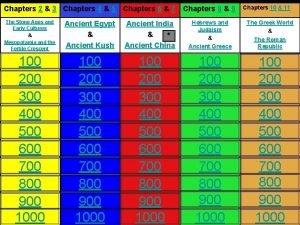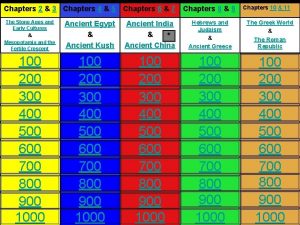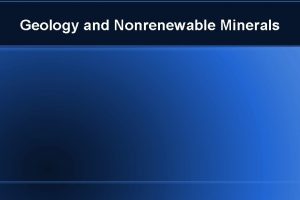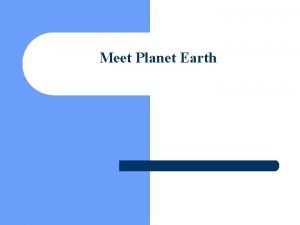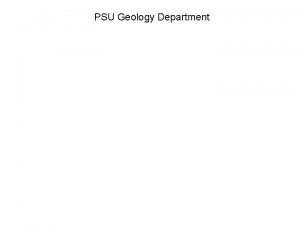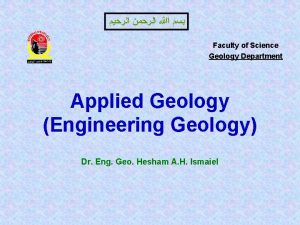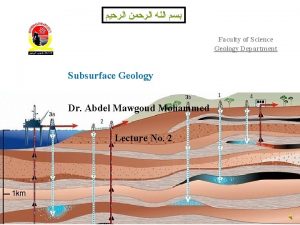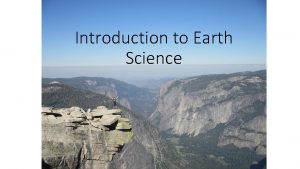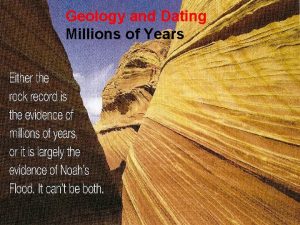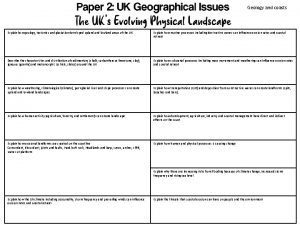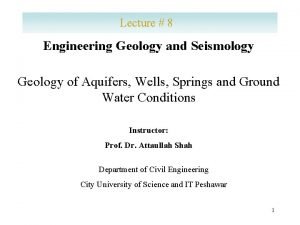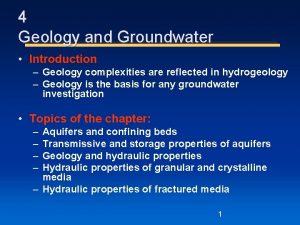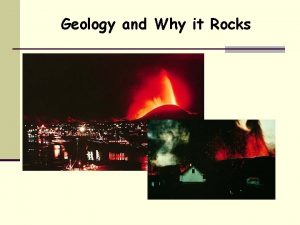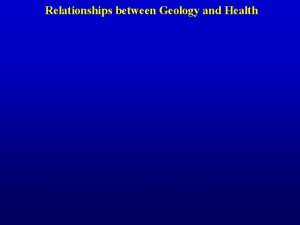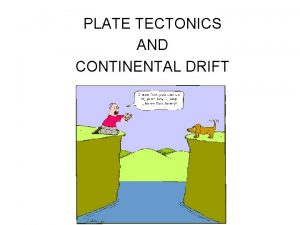Geology Chapters 5 and 6 Science of Geology

































- Slides: 33

Geology Chapters 5 and 6

Science of Geology 0 Geology is the study of planet Earth, including its composition and structure. 0 Scientists who study the Earth are called geologists.

Geologists Divide the forces that change Earth’s surface into two groups Constructive forces Destructive forces

Crust 0 Much of the crust is made up of silicates (compounds of silicon and oxygen) 0 Two different types of crust 0 Continental- less dense rock such as granite 0 Oceanic- more dense rock such as basalt

Rocks 0 Solid combination of minerals or mineral material 0 Much of the Earth’s surface is covered with plants and soil, but underneath is a layer of solid rock.

Rocks 0 Classified into three groups 0 Igneous- rock that forms from magma 0 Sedimentary- forms as sediment is squeezed and cemented together 0 Metamorphic- changed by temperature, pressure, or reactions with hot water

Rock Cycle A series of processes in which rocks continuously change from one type to another Caused by forces within the earth and at the surface

Minerals 0 Minerals are naturally occurring, inorganic solid with a crystal structure and a characteristic chemical composition. 0 Minerals are the building blocks of rocks.

Bowen’s Reaction Series Illustrates the order in which minerals crystalize.

Minerals 0 Properties to identify minerals: 0 Crystal structure 0 Color 0 Streak 0 Luster 0 Density 0 Hardness 0 Fracture and cleavage

Crystal Structure 0 In minerals, the atoms are arranged in a particular geometric shape, or crystal structure. 0 Some crystals are so small that you must use a microscope while others are as big as a telephone pole.

Color and Streak 0 Some minerals can be identified by a characteristic color. 0 The color or a mineral’s powder or its streak is not always the same color as the mineral itself.

Luster and Density 0 Luster is the way in which a mineral reflects light. Some minerals have a metallic luster while others have a vitreous (glassy) luster.

Density 0 Density is the minerals mass divided by its volume. It depends on the chemical composition.

Hardness 0 The resistance of a mineral to scratching. 0 A hard mineral can scratch a softer mineral, but not the other way around. 0 Scale ranges from 1 -10. Talc (1) – Diamond (10)

Fracture and Cleavage 0 How a mineral breaks 0 Cleavage is a type of fracture in which the mineral tends to split along regular, well defined planes where bonds are the weakest.

Other properties 0 Some minerals dissolve in acid. 0 Others are magnetic. 0 Some have unusual electrical properties.

Igneous Rocks 0 Magma is a mixture of molten rock and gases that forms underground. 0 Magma that flows out of volcanoes is called lava. 0 Intrusive rock- forms underground. 0 Extrusive rock- forms at the Earth’s surface.

Igneous Rocks 0 To identify igneous rocks: 0 Look at chemical composition and texture 0 Textures: 0 0 0 Coarse-grained Fine-grained Porphyritic (large and small crystals) Glassy Vesicular (full of holes)

Granite

Obsidian

Sedimentary Rock 0 Sedimentary rocks form through two main processes: 0 Compaction- the pore space between sediment grains is reduced by weight and pressure of overlaying sands 0 Cementation: is the process in which sediments are glued together by minerals that are deposited in water

Sedimentary Rocks 0 Clastic Rock- rocks that form from the broken fragments of other rocks held together by cement. 0 Chemical Rock- form when minerals precipitate out of solution. 0 Organic Rock- form as the result of organic processes. Shells and skeletons sink to the ocean floor. Over time, the fragments compact and cement together.

Characteristics of Clastic Sediments 0 The physical characteristics of sediments are determined mainly by the way sediments were transported to the place where they were deposited. 0 Four main agents: 0 Water 0 Ice 0 Wind 0 Gravity

Characteristics of Clastic Sediments 0 Sorting occurs when currents of air or water tend to separate sediments according to size. 0 Angularity is caused by collisions of particles during transporting. Particles that travel farther tend to be smoother.

Chert

Limestone

Conglomerate

Metamorphic Rock 0 Most metamorphic rocks form heat, pressure, and hot fluids deep underground. 0 Metamorphism can cause chemical changes and the texture of rocks. 0 Metamorphic rocks often have a striped appearance.

Two Types of Metamorphism 0 Contact- due to contact with magma 0 Regional- due to plate tectonics, and occurs over a large area

Textures of Metamorphic Rocks 0 Foliated: mineral grains are arranged in planes or bands 0 Nonfoliated: mineral grains are not arranged in plains or bands

Gneiss

Quartzite
 What is your favourite science subject
What is your favourite science subject Geology earth science definition
Geology earth science definition Geology earth science definition
Geology earth science definition Earth science vs geology
Earth science vs geology Earth science vs geology
Earth science vs geology Anthropology vs sociology
Anthropology vs sociology Think central k5
Think central k5 Soft science definition
Soft science definition To kill a mockingbird chapters 10-11
To kill a mockingbird chapters 10-11 How to kill a mockingbird chapter 1 summary
How to kill a mockingbird chapter 1 summary Noughts and crosses summary by chapters
Noughts and crosses summary by chapters Summary of gatsby chapter 3
Summary of gatsby chapter 3 Dr jekyll and mr hyde chapter 4
Dr jekyll and mr hyde chapter 4 Chapter 18 charlie and the chocolate factory
Chapter 18 charlie and the chocolate factory To kill a mockingbird chapter 14 summary
To kill a mockingbird chapter 14 summary The scarlet letter chapter 12 summary
The scarlet letter chapter 12 summary Pride and prejudice summary
Pride and prejudice summary Summary of chapter 9 lotf
Summary of chapter 9 lotf The scarlet letter chapter 21-22 summary
The scarlet letter chapter 21-22 summary Plunge and trend
Plunge and trend Latvian environment geology and meteorology centre
Latvian environment geology and meteorology centre Basin and range geology
Basin and range geology Natural vs social science
Natural vs social science What are the branches of natural science
What are the branches of natural science Natural science vs physical science
Natural science vs physical science Applied science vs pure science
Applied science vs pure science Rule of 70 population growth
Rule of 70 population growth Julie lundquist
Julie lundquist The watsons go to birmingham vocabulary
The watsons go to birmingham vocabulary Tuesdays with morrie chapter 1
Tuesdays with morrie chapter 1 The catcher in the rye chapter 6 quotes
The catcher in the rye chapter 6 quotes To kill a mockingbird quiz
To kill a mockingbird quiz What did dill dare jem to do?
What did dill dare jem to do? Tkam chapter 11
Tkam chapter 11

